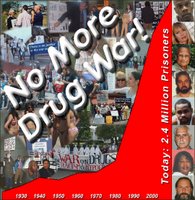Federal crime issues of note
The New York Times recently reported President Bush gutted the F.B.I.’s fraud investigation unit following 9/11.
The Federal Bureau of Investigation is struggling to find enough agents and resources to investigate criminal wrongdoing tied to the country’s economic crisis, according to current and former bureau officials.
The bureau slashed its criminal investigative work force to expand its national security role after the Sept. 11 attacks, shifting more than 1,800 agents, or nearly one-third of all agents in criminal programs, to terrorism and intelligence duties. Current and former officials say the cutbacks have left the bureau seriously exposed in investigating areas like white-collar crime, which has taken on urgent importance in recent weeks because of the nation’s economic woes…
…In the last four years, the Justice Department has scored fewer of the big-name prosecutions that marked President Bush’s first term in office. Even when investigations have pointed to corporate wrongdoing, the Justice Department has agreed, in dozens of cases in the last four years, to “deferred prosecutions" that allowed companies to pay fines in order to avoid criminal prosecution.
Business Week offered another take:
AIG Fraud Case: Using the Market to Set Jail Terms, Under new federal guidelines, defendants in big stock swindles could get 30 years to lifeI have to agree, prosecutorial power threatening some people with life in prison, will start a “liars festival” just like it does in drug prosecutions. And these types of prosecutions seldom lead to culpable offenders punished appropriately — it leads guys and gals last in line, or those who stubbornly takes his or her case to trial — decades to life in federal prison. People will say anything under stress and duress of federal indictment, and to get out from underneath the weight of it. The Innocence Project has discovered and explored this easily exploited human tendency. That said, there will never be thousands upon thousands of “Organizational Offenders” (corporate and business fraud offenders) to warrant enough public pressure for their earned, early release, even if the wrong people end up in federal prison. With ill gotten goods confiscated, some will lack political power they had in two decades past. They’ll be just like us, only there won’t be many of them — a few hundred before this new federal ‘witch-hunt’ is over, perhaps — and victimized people won't be satisfied.
In coming weeks, five former insurance executives, including General Reinsurance ex-CEO Ronald Ferguson, are due to appear in federal court in Hartford. There, U.S. District Judge Christopher F. Droney will sentence them for their role in a sham transaction to boost the loss reserves of American International Group (AIG). When the deal was disclosed in 2005, prosecutors contend, it caused AIG's share price to drop 6% to 15%. Because of that, the defendants, who were convicted of fraud in February, could go to prison for life…
…Given the size of losses related to the subprime meltdown, prosecutors may be able to threaten alleged culprits with lifetime incarceration. Reid H. Weingarten, a Washington attorney representing Elizabeth Monrad, the convicted former Gen Re CFO, argues that "this puts unhealthy leverage in prosecutors' hands to extract unfair plea deals.
Before anyone rushes to condemn and terrify the offenders in the financial collapse, we need instead, to use this criminal financial crisis to re-visit powers of prosecutors, the politicization of crime, and what our incarceration system is supposed to achieve — especially on the federal level. If it is to build and maintain public and private gulags, without thought to the cost to our economy and human resources, remind your leaders over-incarceration doesn’t work. When people go home, they are broken, not better.
Financial institutions and powerful corporations leaned on the Sentencing Commission when mandatory minimum sentencing provisions for 'organizational crimes' were developed. How much imprisonment can our citizens tolerate?
There are about 113,500 drug offenders in federal prison today and most took plea bargains because they were threatened with decades of prison time. There are growing numbers of drug lifers, like Sharanda Jones who’ll die behind bars, without public intervention. Please read Sharanda’s story.
The country’s federal crime policy needs thoughtful revision, not another half-baked witch hunt that victimizes more people than any justice it metes out. Eroded constitutional rights, need restoration. “I love my country, but fear my government,” sits on the lips of too many good citizens. Returning to rule of law, and transparent legal procedures would restore citizen trust. Without trust in our leaders and powerful legal institutions, citizens will battle, not stand with their leaders.
Labels: mandatory minimum sentencing, organizational offenders, US Sentencing Guidelines




